Askey Computer WLL0010 Wireless Lan Mini-Pci card User Manual 11Mbps Wireless LAN Card User s Manual
Askey Computer Corp Wireless Lan Mini-Pci card 11Mbps Wireless LAN Card User s Manual
Manual revised

I
11Mbps Wireless LAN Card
User’s Manual

11Mbps Wireless LAN Card User's Manual
II
2003 All rights reserved. No part of this document may be reproduced or transmitted in any
form or by any means, electronic or mechanical, for any purpose, without the express written
permission of the seller.
Disclaimer
Information in this document is subject to change without notice. The material contained
herein is supplied without representation or warranty of any kind. The seller therefore assumes
no responsibility and shall have no liability of any kind arising from the supply or use of this
document or the material contained herein.
Trademarks
Microsoft and Windows are registered trademarks of Microsoft Corporation. All other
trademarks mentioned in this document are the property of their respective owners.
Doc: SAVD-UM-WLWLL0010-V01
MAC: 00:E0:4C:AB:CD:AB
Utility: 2.1
13-08-2003

Contents
III
Contents
About This Manual........................................................................................................................................................V
Chapter 1 Introduction............................................................................................................................................... 1
Wireless LAN Basics................................................................................................................................................... 2
Local Area Network (LAN) .......................................................................................................................................................2
Ad-Hoc Mode ............................................................................................................................................................................3
Infrastructure Mode ..................................................................................................................................................................4
Roaming ....................................................................................................................................................................................5
Chapter 2 Installing the Wireless LAN Card............................................................................................................ 7
System Requirements................................................................................................................................................. 8
Installing Wireless LAN Driver and Software .............................................................................................................. 9
Chapter 3 Using Wireless LAN Utility .................................................................................................................... 13
Accessing Vendor’s Wireless LAN Utility.................................................................................................................. 14
Notice When Assessing Wireless LAN Utility under Windows XP..........................................................................................16
Configuration............................................................................................................................................................. 18
Available Wireless Networks...................................................................................................................................................18
Available Profiles....................................................................................................................................................................20
WEP Settings...........................................................................................................................................................................21
Advanced Configuration............................................................................................................................................ 24
Status ........................................................................................................................................................................ 26

11Mbps Wireless LAN Card User's Manual
IV
Statistics.................................................................................................................................................................... 27
About ......................................................................................................................................................................... 29
Chapter 5 Windows XP Wireless Zero Configuration Utility ............................................................................... 31
Connecting to an Access Point or Wireless LAN Card ............................................................................................. 31
Viewing Wireless Connection Status ........................................................................................................................ 34
Configuring Your Wireless Properties....................................................................................................................... 35
Chapter 6 Uninstalling the Wireless LAN Card..................................................................................................... 41
Uninstalling the Wireless LAN Card Software........................................................................................................... 41
Chapter 7 Troubleshooting ..................................................................................................................................... 45
Appendix A Limited Warranty................................................................................................................................. 49
Wireless LAN Hardware............................................................................................................................................ 49
Wireless LAN Software ............................................................................................................................................. 50
Appendix B Setting Up TCP/IP................................................................................................................................ 51
For Windows 98/ME.................................................................................................................................................. 51
For Windows 2000/XP .............................................................................................................................................. 54
Glossary....................................................................................................................................................................... 57

Contents
V
About This Manual
This manual was written for the following type of wireless adapter:
• Mini-PCI Wireless Adapter
For brevity, throughout this manual Wireless LAN Card is used to indicate the wireless
adapter. Also, the following terms/abbreviations are used interchangeably:
• Access Point – AP
• Peer-to-Peer – Ad Hoc
• Wireless LAN – WLAN
• Ethernet network – LAN – network
This User’s Manual contains information on how to install and configure your Wireless LAN
Card. From now on, we will guide you through the correct configuration steps to get your
device up and run.
1
Chapter 1 Introduction
This Wireless LAN Card is an IEEE 802.11b Wireless LAN (Mini-)PCI adapter. It allows
your computer to connect to a wireless network and to share resources, such as files or printers
without being bound to the network wires. Operating in 2.4GHz Direct Sequence Spread
Spectrum (DSSS) radio transmission, the Wireless LAN Card transfers data at speeds up to
11Mbps. Both Ad-Hoc and Infrastructure mode are supported. For network security concern,
40/104-bit Wired Equivalent Privacy (WEP) algorithm is used. In addition, its standard
compliance ensures that it can communicate with any 802.11b networks.

11Mbps Wireless LAN Card User's Manual
2
Wireless LAN Basics
This section contains some Wireless LAN basics to help you better understand how the
product work together to create a wireless network.
Local Area Network (LAN)
Simply put, a LAN is a network that exists in a relatively limited area. A network is two or
more computers connected together sharing files and peripheral devices such as printers.
The Wireless LAN Card allows you to interact with other computers without having to run
cables normally associated with networks. This lets you move your computer around while
staying connected to your network.
There are two ways to use the Wireless LAN Card. One way is to connect directly to one or
more Wireless LAN Card equipped computers, forming an Ad-Hoc wireless network. The
second way is to connect to an Access Point that gives you access to an existing wired LAN,
forming an Infrastructure wireless network.
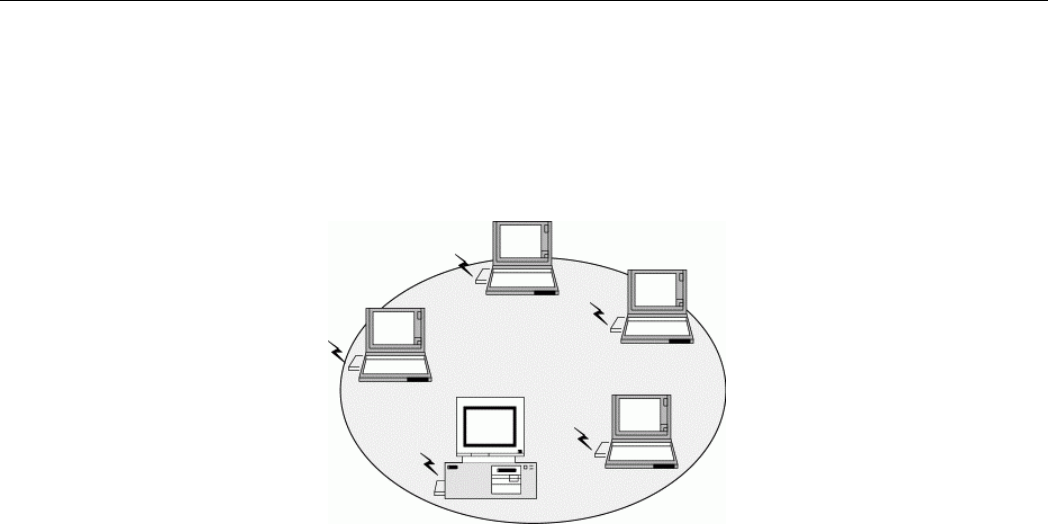
Chapter 1 Introduction
3
Ad-Hoc Mode
The Ad-Hoc Group offers peer-to-peer connections between workstations, allowing
communication between computers within range that have a Wireless LAN Card installed. A
wireless Ad-Hoc network can also access a wired LAN’s TCP/IP service (such as e-mail and
the Internet) by using a TCP/IP software router on an Ethernet equipped PowerBook or
notebook.
Figure 1-1 Ad-Hoc Mode
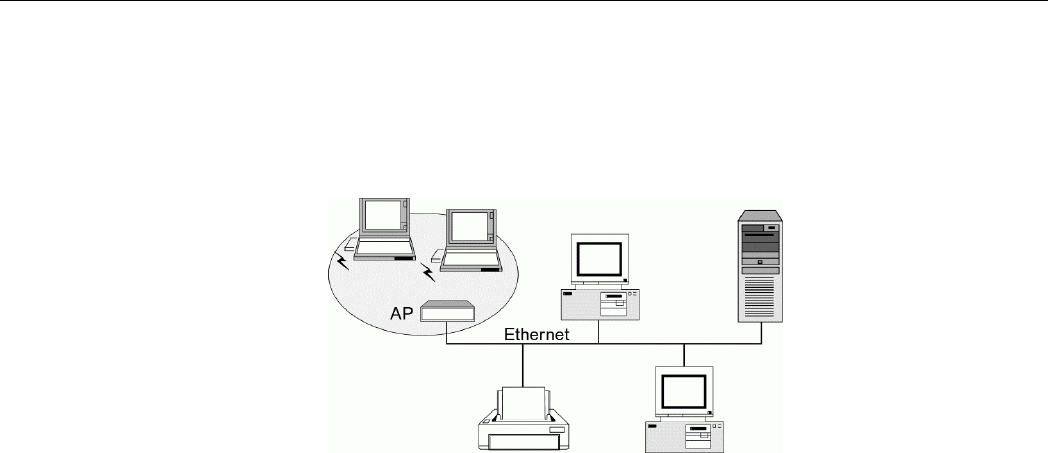
11Mbps Wireless LAN Card User's Manual
4
Infrastructure Mode
The Infrastructure network uses an AP or several APs as a gateway, linking the wireless
network to a wired LAN. As a result, portable workstations or desktops on your wireless
network have access to all of the features of your wired LAN including e-mail, Internet access,
network printers and file server.
Figure 1-2 Infrastructure Mode
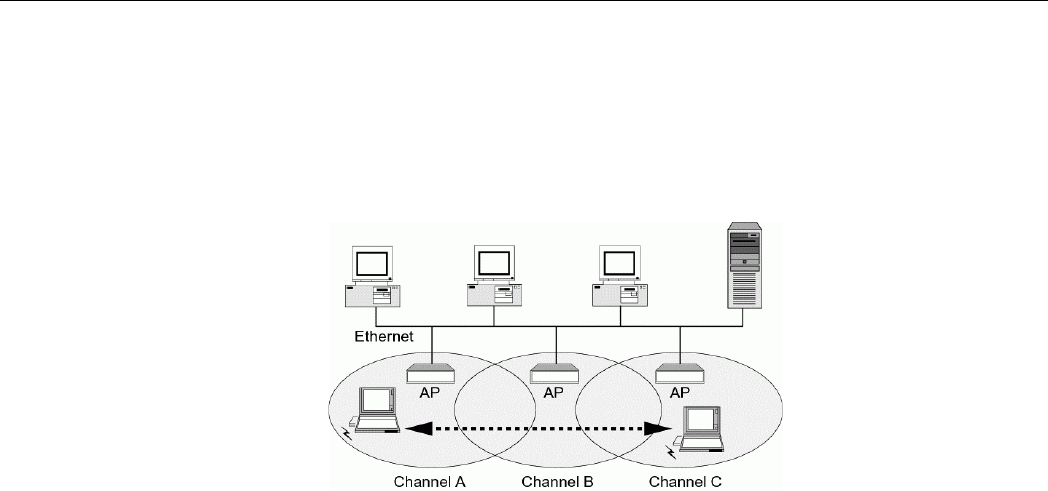
Chapter 1 Introduction
5
Roaming
Multiple Access Points can be installed to extend the wireless service coverage area for
seamless wireless access. Within an extended service area, all Access Points and wireless
clients must have the same Service Set Identity (SSID). Roaming among different Access
Points is controlled automatically to maintain the wireless connectivity at all times.
Figure 1-3 Roaming Across Multiple Access Points

7
Chapter 2 Installing the Wireless LAN Card
This chapter describes the installation process of the driver and software for the Wireless LAN
Card. Proper driver installation is to allow the device to operate on your host computer while
the utility software, Wireless LAN Utility, is to help you configure and monitor your Wireless
LAN Card.
In case you need to install the driver and software for any reason, follow the instructions
described in this chapter.
Note: The installation procedures are basically the same in Windows operating system. The
following description uses Windows XP as the example environment.

11Mbps Wireless LAN Card User's Manual
8
System Requirements
To use the Wireless LAN Card, your computer must meet the following minimum
requirements:
! Pentium-class PC, 300MHz or better recommended
! 64 MB of RAM, additional memory recommended
! Hard disk space at least 30 Mbytes
! Windows 98(SE)/Me/2000/XP
! UL listed I.T.E. computers
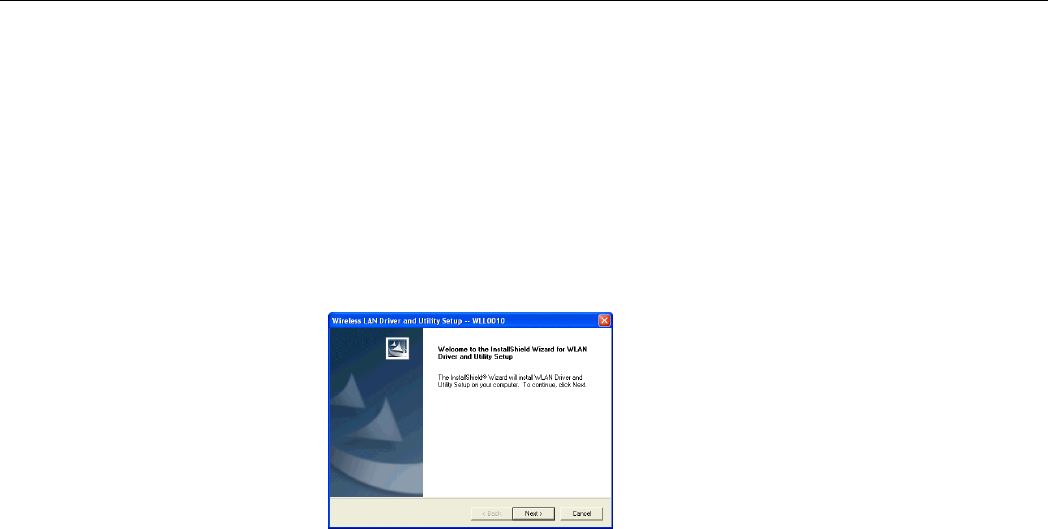
Chapter 2 Installing the Wireless LAN Card
9
Installing Wireless LAN Driver and Software
This section describes how to install the wireless adapter driver and software. Windows 98,
Me, 2000, and XP use the same setup program; however, operation system-specific situation
may occur during or after the installation process.
Follow these steps to install the wireless adapter driver and software.
1. Run Setup.exe from D:\Utility&Driver folder of the Software Utility CD where D is the
drive letter. When the welcome screen pops up, click Next.

11Mbps Wireless LAN Card User's Manual
10
2. When the License Agreement screen appears, click Next.
• For Windows XP users, if Windows logo compatibility message appears, click
Continue Anyway to proceed with the installation.
• For Windows 2000 users, if you are prompted with the Digital Signature not
Found alarm message, click Yes.
• For Windows 98se users
- When prompted to insert the installation disk, click OK. The Insert Disk screens
pops up, click the Browse button to locate the driver from
D:\Utility&Driver\Win98 of the Software Utility CD where D is the drive letter.
- When prompted for Windows 98(SE) CD-ROM, click OK. Then enter the path to
your Windows 98(SE) original files, and click OK.
If Windows 98(SE) original files are not on your computer, you will need to remove
the Software Installation CD and then insert your Windows 98(SE) installation CD.
Otherwise just locate the Windows 98 CAB files on your computer.
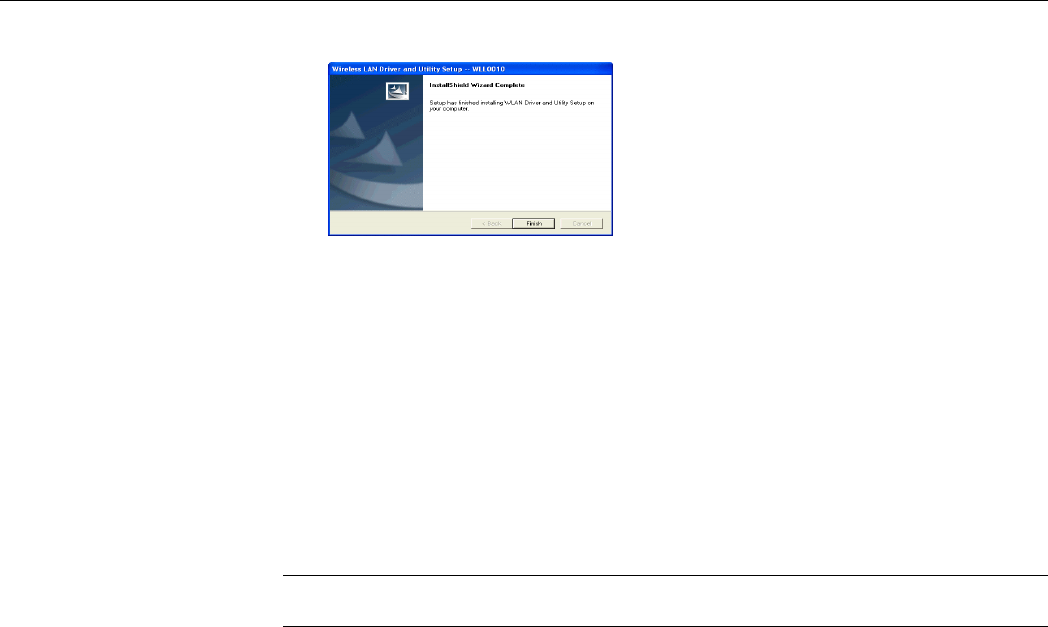
Chapter 2 Installing the Wireless LAN Card
11
3. Click Finish.
4. Different situations will occur according to your OS. Follow the OS-specific instructions
to complete the installation.
For Windows 2000 and XP
• The installation process is complete.
For Windows ME
• You will be prompted to restart your computer, click OK.
• When prompted to restart your computer again, click Yes.
For Windows 98se
• When prompted to restart your computer, click OK.
Note: If you need to set up the TCP/IP address or the subnet mask, refer to “Appendix B
Setting Up TCP/IP” for details.
13
Chapter 3 Using Wireless LAN Utility
Once your wireless adapter driver and software is properly installed, the provided Wireless
LAN Utility is ready for use. You should be able to find the wireless icon on your system tray.
See the ensuing subsections for instructions on using the vendor-provided wireless utility.
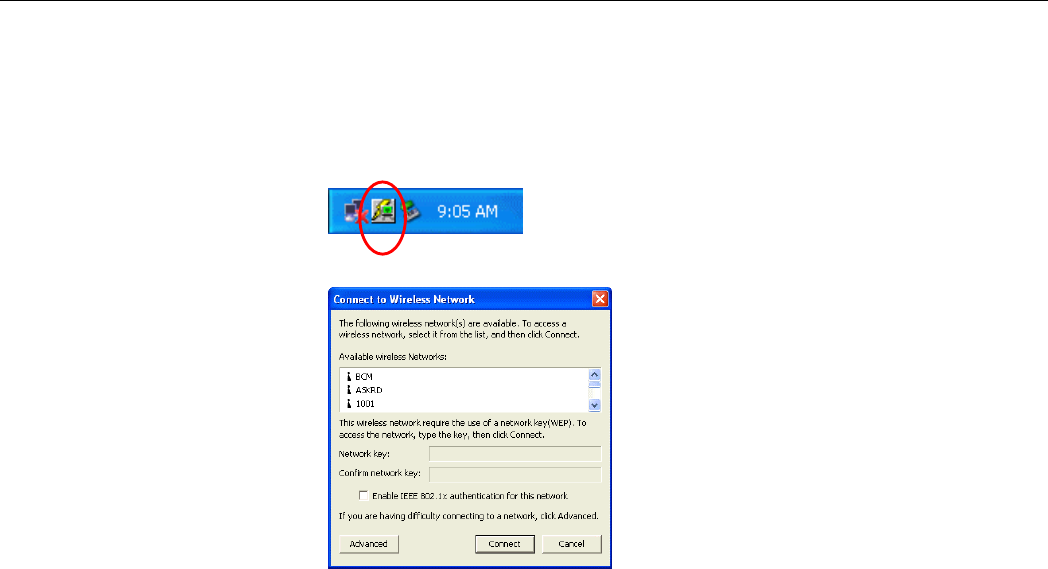
11Mbps Wireless LAN Card User's Manual
14
Accessing Vendor’s Wireless LAN Utility
To access vendor-provided Wireless LAN Utility:
1. Double-click the wireless icon on the system tray.
2. Click the Advanced button.
3. The vendor-provided utility is launched. You may click the menu on the left to execute
corresponding tasks.
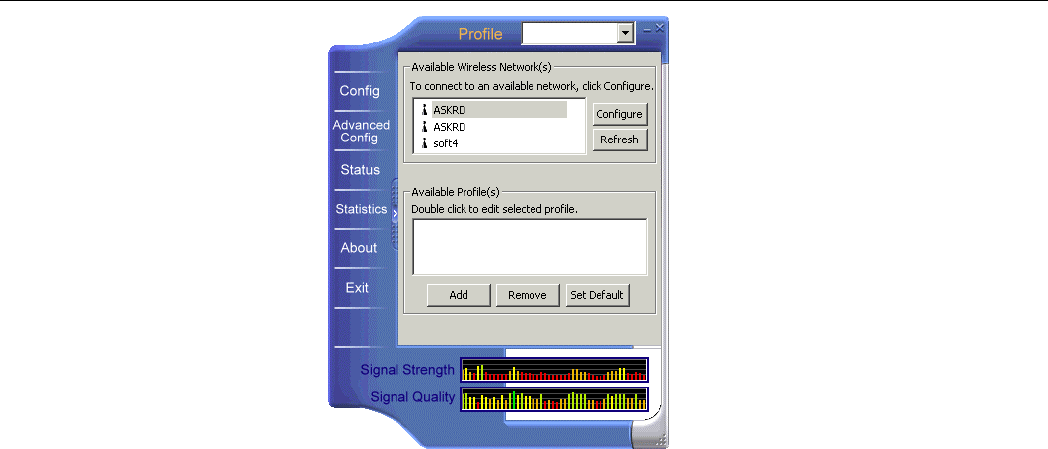
Chapter 3 Using Wireless LAN Utility
15

11Mbps Wireless LAN Card User's Manual
16
Notice When Assessing Wireless LAN Utility under Windows XP
Aside from using the vendor’s WLAN utility for configuration, Windows XP includes a
Wireless Zero Configuration Utility for you to configure your wireless adapter. By default,
your wireless adapter is managed by Windows XP-included wireless utility. Under this
circumstance, you will be prompted with the “You are in “Windows Config” mode” message
if you try to access vendor-provided utility by double-clicking vendor’s wireless icon in the
system tray.
You can choose to configure your wireless network via either the vendor’s Wireless LAN
Utility or Windows XP-included wireless utility.
Using Vendor’s Wireless LAN Utility
To use the vendor’s WLAN utility for configuration purposes, you should disable the
Windows XP-included wireless utility by these steps:
4. Double-click the Windows XP wireless tray icon and then click Properties (or
Advanced). Then select Wireless Networks tab.
Vendor’s wireless icon
Windows XP wireless icon
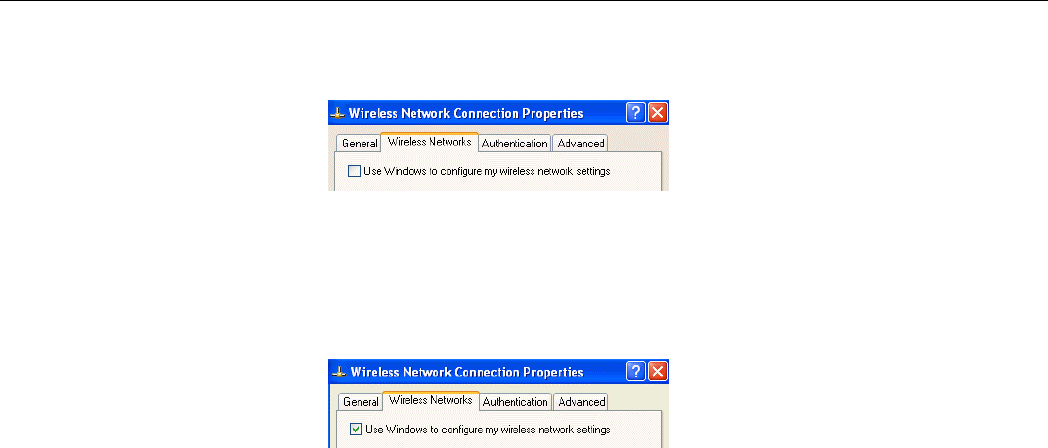
Chapter 3 Using Wireless LAN Utility
17
2. On the Wireless Networks tab, uncheck the Use Windows to configure my wireless
network settings box and click OK. This will restore the Wireless Networks tab in
wireless LAN utility.
Reverting back to Windows XP-included Wireless Utility
Double-click the Windows wireless icon (not the vendor’s WLAN utility icon) and then click
Advanced (or Properties). Click the Wireless Networks tab and check the Use Windows to
configure my wireless network settings box and click OK.
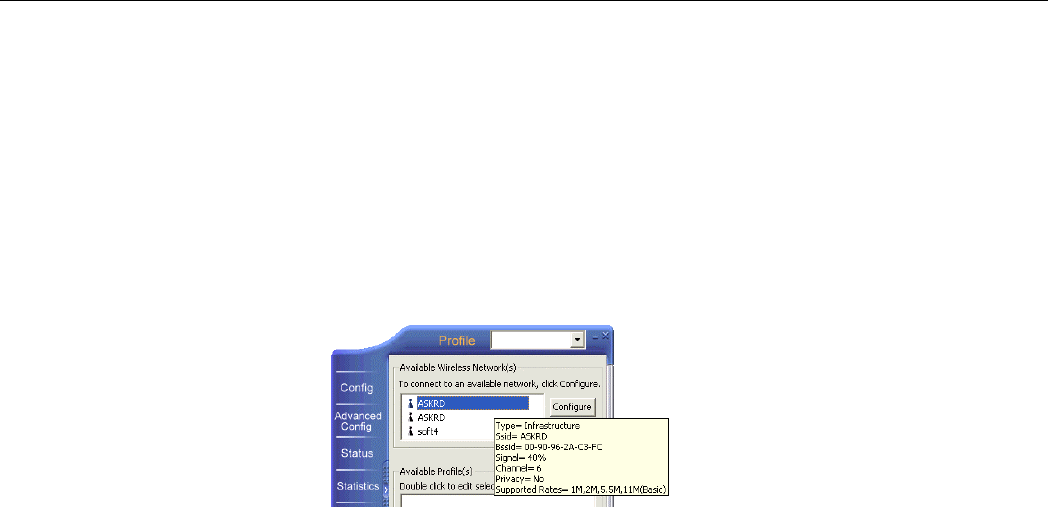
11Mbps Wireless LAN Card User's Manual
18
Configuration
The Config screen comprises two sections: Available Wireless Networks and Available
Profiles.
Available Wireless Networks
The utility automatically searches and displays available “open” wireless networks in this list.
Highlighting a network will pop up the related parameters used by the network.
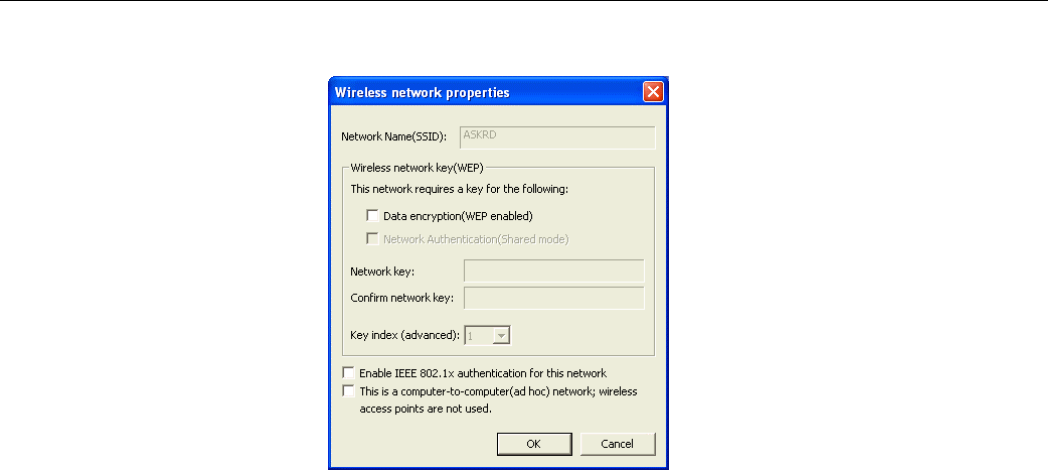
Chapter 3 Using Wireless LAN Utility
19
If you select a network and click Configure, you can configure the WEP and 802.1x settings.
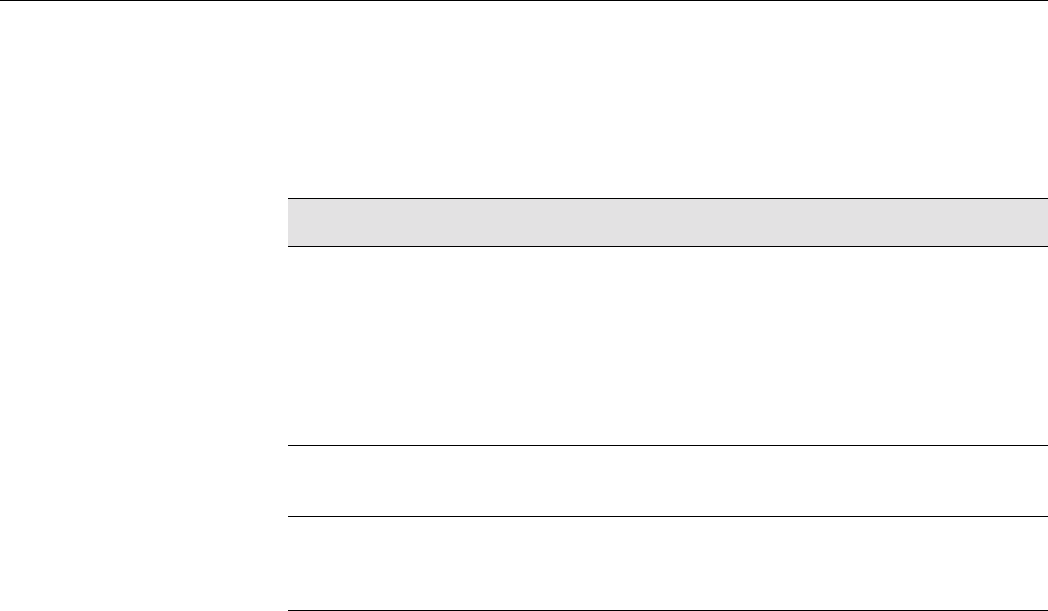
11Mbps Wireless LAN Card User's Manual
20
Available Profiles
This section allows you to add, edit and remove a profile.
To add a new profile, click Add and then set up these parameters:
Screen Item Description
SSID Specifies the name of the WLAN group you want to participate in.
For Ad Hoc mode: A network name is mandatory. The SSID for
all stations in a single Ad Hoc network must be same.
For Infrastructure mode: If using the special SSID “any”, your
Wireless LAN Card will connect to the first compatible and “open”
AP with the best signal strength within the connection range.
WEP Specifies whether to enable WEP settings. See next section for more
information.
802.1x Do not check the “Enable IEEE 802.1x authentication for this
network” option unless you are going to join a 802.1x-enabled
wireless network.

Chapter 3 Using Wireless LAN Utility
21
Screen Item Description
Operating Mode To join an Ad-Hoc network, check the “This is a
computer-to-computer (ad-hoc) network…” check box.
To join an Infrastructure network where an AP is required, leave the
“This is a computer-to-computer (ad-hoc) network…” check box
unchecked.
WEP Settings
In the WEP section you may take additional measures to secure your network by using WEP
(Wired Equivalent Privacy). If encryption is not necessary, just leave the Data
encryption(WEP enabled) check box empty. To enable WEP, take the steps below:
1. Check the Data encryption (WEP enabled) check box.
2. In the Network Authentication (Shared Mode) item, select this check box to use
Shared Key or leave it empty to use Open Key. You should use the same authentication
method as used by your targeted wireless network.
• Open Key: If your targeted wireless network uses Open Key, your authentication
request will be always accepted regardless of your WEP keys. You are allowed to
join the network assuming that your SSID matches the SSID of the targeted
wireless network.

11Mbps Wireless LAN Card User's Manual
22
• Shared Key: If your targeted wireless network uses Shared Key, your wireless
adapter must be set to use correct WEP to pass the authentication. If selected, your
wireless adapter must use identical WEP keys as the targeted wireless network.
3. In the Network key and Confirm network key fields, enter 40bits or 104bits WEP keys
in hexadecimal format. Note that the WEP keys must be the same as your target wireless
network.
When using Hexadecimal format, only digits 0-9 and letters a-f, A-F are allowed. Make
sure to enter the character matching the required key format and length as below:
ASCII characters Hexadecimal digits
40 bits 5 alphanumeric characters 10 hexadecimal digits
104 bits 13 alphanumeric characters 26 hexadecimal digits
4. In the Key index (advanced) field, select an index for the key you entered.
After finishing all required settings, click OK. You will return to the Config screen and found
the new profile named after the SSID you entered in the Available Profiles list.
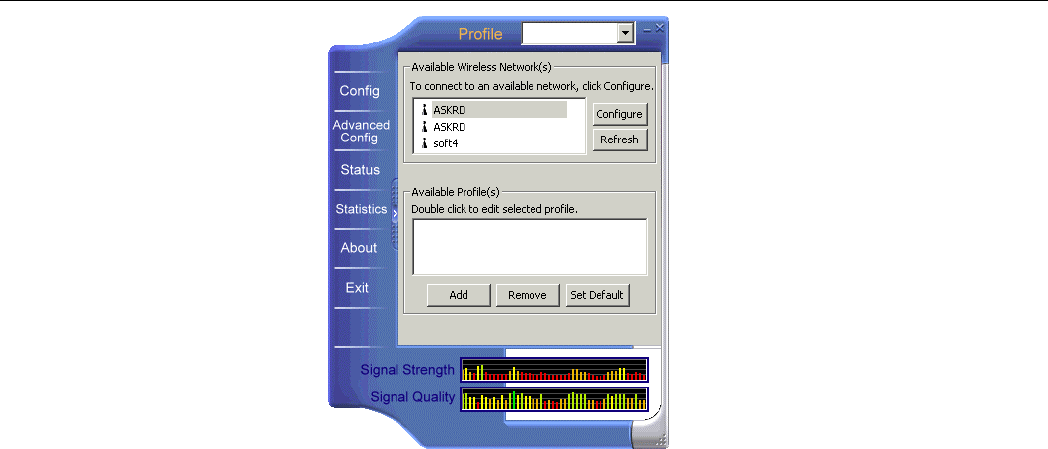
Chapter 3 Using Wireless LAN Utility
23
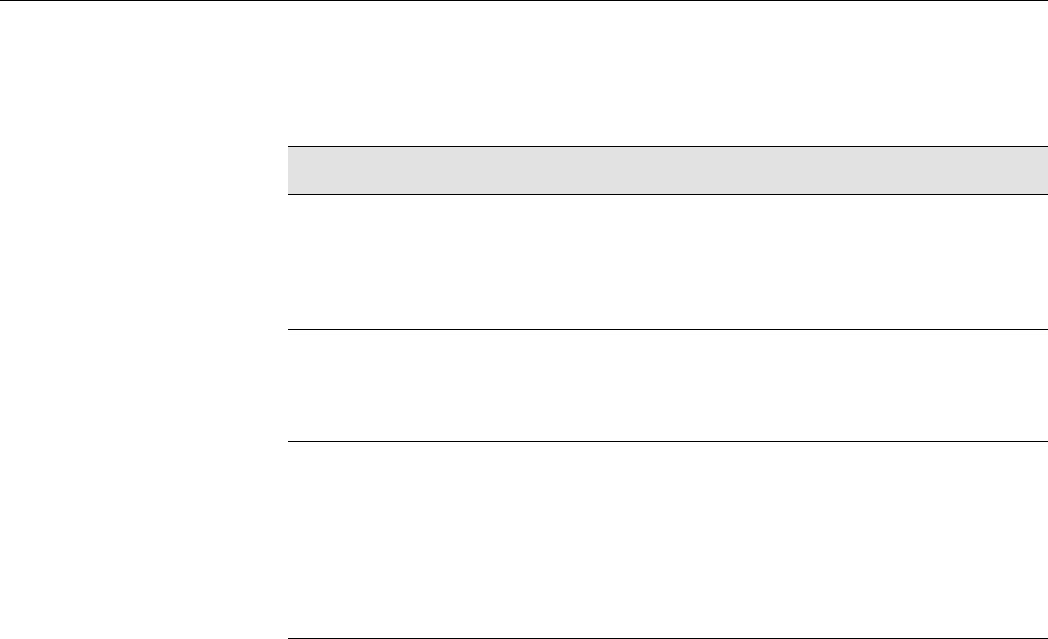
11Mbps Wireless LAN Card User's Manual
24
Advanced Configuration
The following table lists the parameters on this screen:
Screen Item Description
Ad Hoc default channel This setting determines which channel is to be used if your wireless
adapter is the first to start an Ad Hoc network.
When selecting a channel, make sure to select a legal channel
according to your frequency domain.
Encryption Specifies the encryption as WEP, TKIP or AES.
Note:
The current driver/utility only supports WEP encryption mode.
Preamble Mode The preamble is part of the IEEE 802.11b physical layer
specification. All 802.11b devices are mandatory to support the
long preamble format, but may optionally support the short
preamble. This Wireless LAN Card supports the short preamble.
The Short option allows to communicate with other 802.11b
devices which support short preamble to boost the throughput. The
Long option is typically used in a “noisy” network. Make sure to
use the a
pp
ro
p
riate
p
reamble t
yp
e accordin
g
to
y
our network

Chapter 3 Using Wireless LAN Utility
25
Screen Item Description
environment.
Show icon in system
tray Specifies whether to show wireless icon in the system tray.
Radio Off Allows to disable/enable RF signal.
Power Save Specifies the power save mode to be used.
Rescan Allows to rescan the current associated network.

11Mbps Wireless LAN Card User's Manual
26
Status
This screen displays the detailed informatoin on your current wireless connecton.
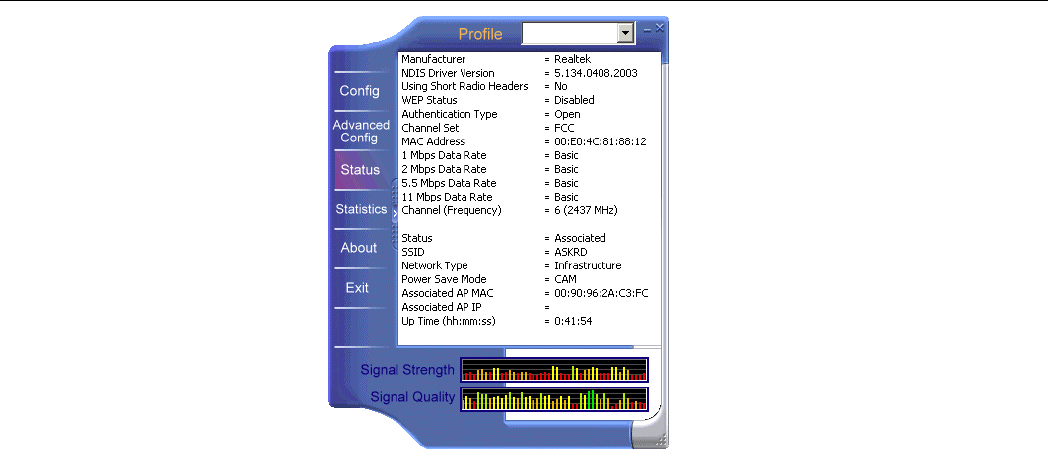
Chapter 3 Using Wireless LAN Utility
27
Statistics
This screen displays the statistics data on your current wireless connecton. You can
optionally click the Reset button to set the couter to zero.
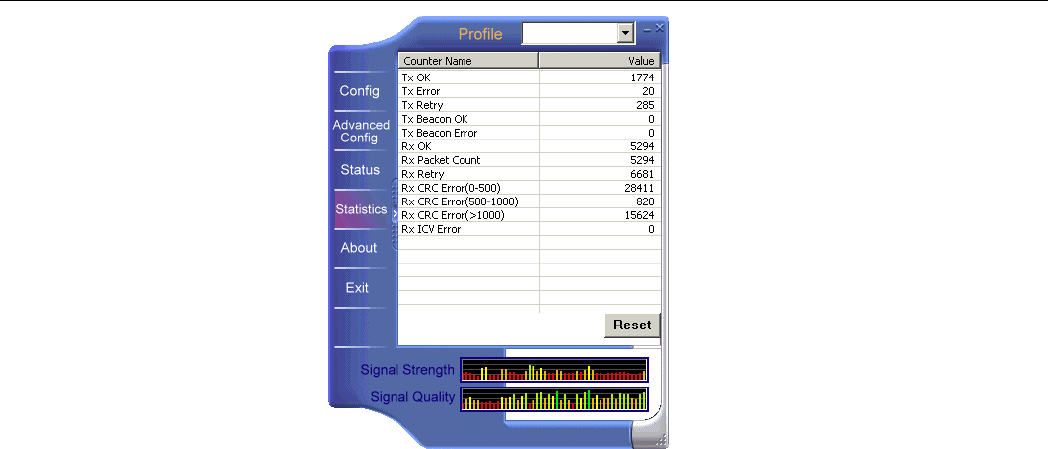
11Mbps Wireless LAN Card User's Manual
28
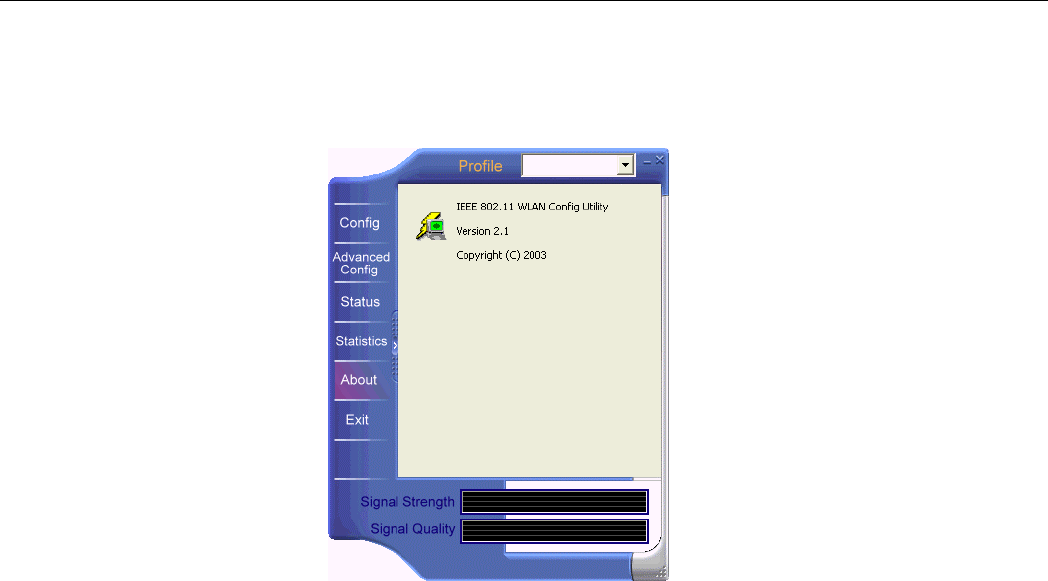
Chapter 3 Using Wireless LAN Utility
29
About
The About screen displays information about the utility version.

31
Chapter 5 Windows XP Wireless Zero Configuration Utility
Windows XP provides built-in Wireless Zero Configuration utility for wireless
configuration and monitoring. You can choose to configure your wireless network via either
the wireless LAN utility as described in preceding section, or to use the Windows XP
Wireless Zero Configuration utility.
This section only provides the essential instructions on using Windows XP wireless utility to
get your wireless network established. For more information please refer to Windows XP
on-line help.
Connecting to an Access Point or Wireless LAN Card
To connect to an existing Access Point/Wireless LAN Card, take out the following steps:
1. Right-click the Wireless Connection icon on the system tray and select View Available
Wireless Networks from the context menu.
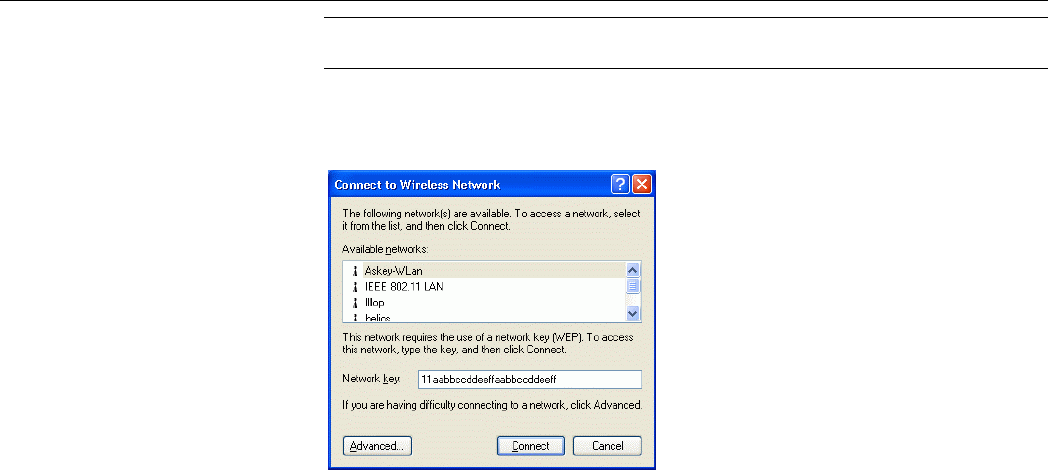
11Mbps Wireless LAN Card User's Manual
32
Note: Depending on whether your wireless network is established, the context menu may
come with different items.
2. When the Connect to Wireless Network window pops up, you will see all the Access
Points or Wireless LAN Cards that are available in the air. Select the wireless network
you want to connect to .
Figure 5-1 Windows XP Configuration Utility-Connect to Wireless Network
3. If the target Access Point/Wireless LAN Card has been set with WEP key, you must
enter the same WEP key in the Network key field. Otherwise, leave it blank.

Chapter 5 Windows XP Wireless Zero Configuration Utility
33
4. Click Connect, then you will join the target network and this dialog window will
disappear. When your wireless connection is established, the connection icon appears as
below:
Note: If the wireless connection can’t be established, double-click the connection icon and
then click Properties. Go to Authentication tab first to make sure that you use the correct
authentication type for the Wireless LAN Card. For more information, refer to
“Authentication” on page 39.
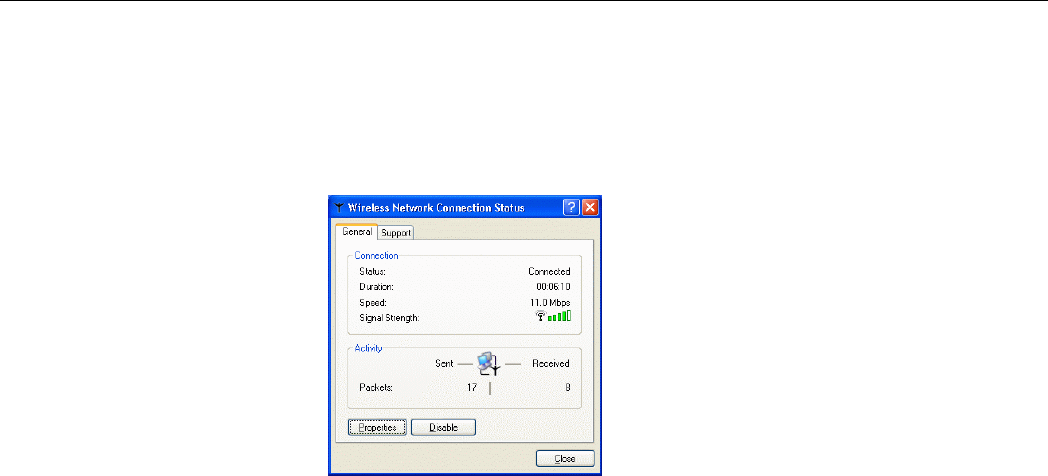
11Mbps Wireless LAN Card User's Manual
34
Viewing Wireless Connection Status
After you successfully connect to the Access Point or Wireless LAN Card, double-click the
icon in the system tray again. This will open the Wireless Network Connection Status
window where you can see the general data of the Wireless LAN Card, such as Status,
Duration, Speed, Signal Strength, etc.
Figure 5-2 Windows XP- Connection Status
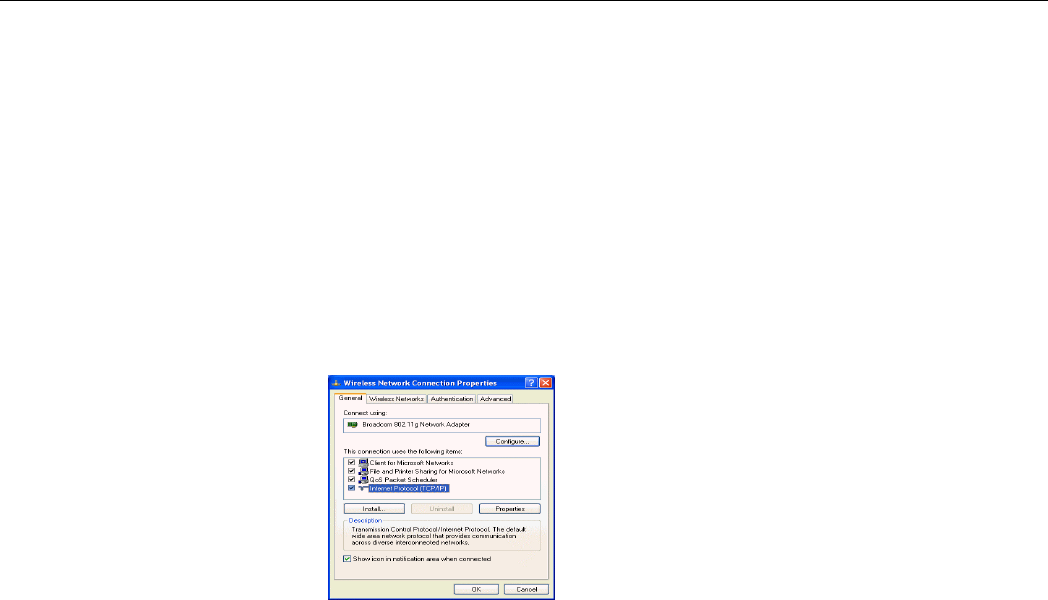
Chapter 5 Windows XP Wireless Zero Configuration Utility
35
Configuring Your Wireless Properties
To configure your wireless properties, open the Wireless Network Connection Status
window as described above, and then click the Properties button. This will open the Wireless
Network Connection Properties window which allows you to configure more detailed items
of the Wireless LAN Card. The following describes each tab of the properties window to help
you do more settings of the Wireless LAN Card.
General
This tab allows you to specify the network methods to be used with your Wireless LAN Card.
The network policy depends on your wireless network. For TCP/IP protocol, you should
configure its properties as instructed by your network administrator. For more information on
TCP/IP setting, please refer to “Appendix B Setting Up TCP/IP” on page 51.
Figure 5-3 Windows XP Connection Properties -General
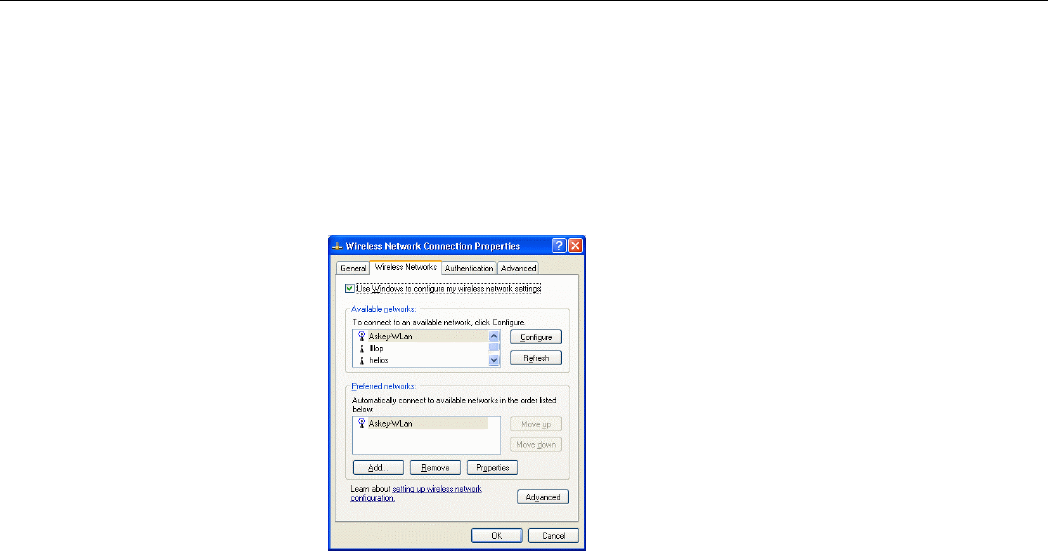
11Mbps Wireless LAN Card User's Manual
36
Wireless Networks
This tab contains two sections: Available networks and Preferred networks described as
below.
Under Available networks section, you can also see all the Access Points and Wireless LAN
Cards available in the air. Click Refresh to update the list of Access Points and Wireless LAN
Cards.
Figure 5-4 Windows XP Connection Properties-Wireless Networks
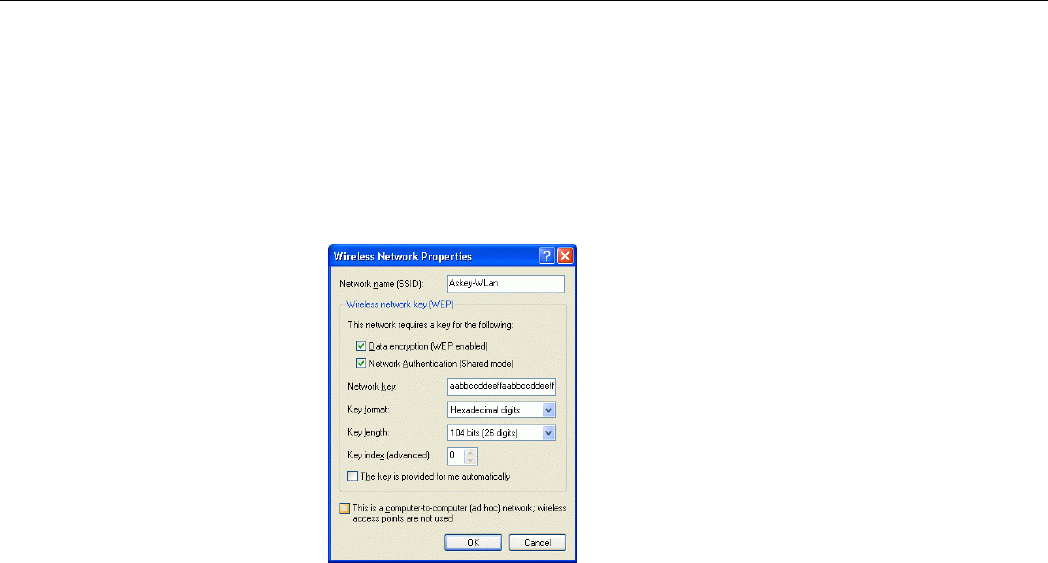
Chapter 5 Windows XP Wireless Zero Configuration Utility
37
Under Preferred networks section, you can add any wireless networks that you wish to
connect to. To do this, just click Add to add more Access Points or Wireless LAN Cards to
the list.
After you click the Add button, the Wireless Network Properties window pops up. Type
your network name (SSID) and, if needed, the wireless network WEP settings. Once the
Access Point or Wireless LAN Card that you want to connect to has been set with WEP key,
you must type the same WEP key as the Access Point’s or Wireless LAN Card’s.
Figure 5-5 Windows XP-Add Preferred Networks

11Mbps Wireless LAN Card User's Manual
38
After you add several profiles into Preferred networks, you can change the order in which
connection attempts to preferred networks are made. Just select the target wireless network
and click Move up or Move down to move it to a desired position.
To Access Certain Wireless Network Only
If you just want to access certain wireless network type, click the Advanced button on the
Wireless Networks tab to open the Advanced window. You can choose to connect to the
following networks:
• Any available network (access point preferred)
• Access point (infrastructure)
• Computer-to-computer (Peer-to-Peer Group)
The default network type is Any available network (access point preferred). In this network
type, your device will connect to any Access Points or Wireless LAN Cards available in the
air but Access Point always demands higher connection attempt priority.

Chapter 5 Windows XP Wireless Zero Configuration Utility
39
Once you finish the advanced setting, your wireless station will then connect to your desired
network and the connected network will be listed under Available networks.
Figure 5-6 Windows XP Configuration Utility-Set up a Network to Aceess
Authentication
This tab allows you to configure the authentication settings of your Wireless LAN Card. The
most important setting for the Wireless LAN Card is to disable Enable network access
control using IEEE802.1X to ensure successful connection between the Wireless LAN Cards
and Access Points or other Wireless LAN Cards. You must disable this function for any
reason. Otherwise, there may be some problems happening during connection. For other
settings, we recommend you keep the default settings to minimize the problems during
connection.
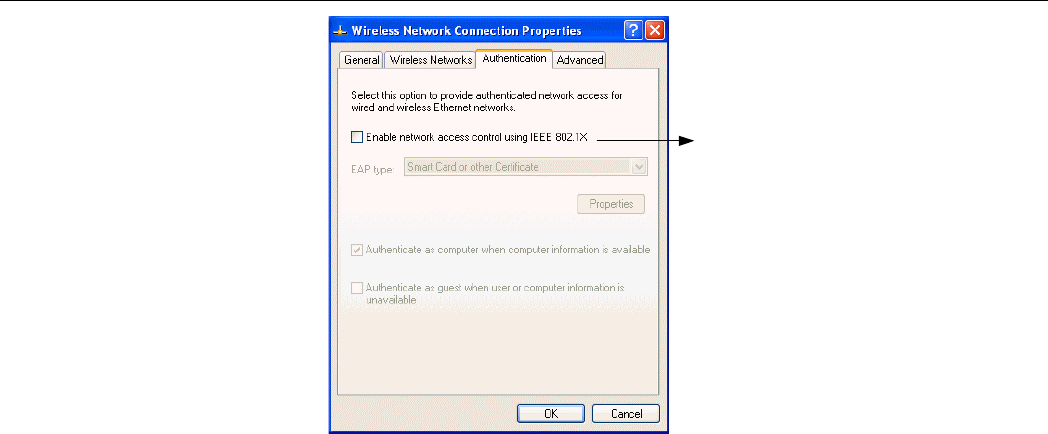
11Mbps Wireless LAN Card User's Manual
40
Figure 5-7 Windows XP Connection Properties – Authentication
Make sure to disable Enable
network access control
using IEEE 802.1X.

41
Chapter 6 Uninstalling the Wireless LAN Card
Should you need to uninstall the Wireless LAN Card and application software for any reason,,
you should uninstall the associated software and then remove the hardware from your
computer. Please proceed as follows.
Uninstalling the Wireless LAN Card Software
Note: Before uninstalling the Wireless LAN Card software, please disable the utility by
right-clicking the utility tray icon and select Close from the context menu. The icon will
disappear to indicate that the utility is not in operation.
1. Close all programs that are currently running.
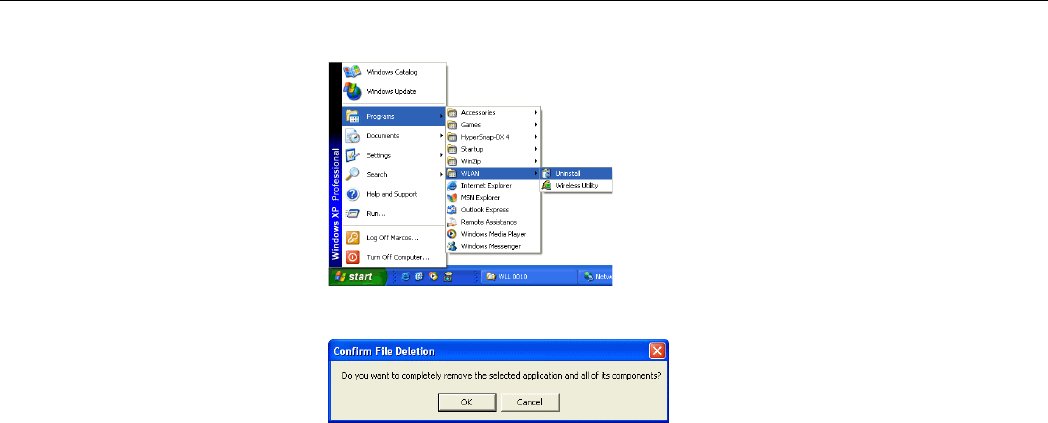
11Mbps Wireless LAN Card User's Manual
42
2. Click the Windows Start > Programs > WLAN > Uninstall.
3. Click OK to proceed with the software removal procedure.
4. If the Lock File Detected screen appears, click the Ignore button.

Chapter 6 Uninstalling the Wireless LAN Card
43
5. When the following screen appears, click Finish. Subject to your Windows OS, you may
be prompted to restart the computer.
45
Chapter 7 Troubleshooting
Cannot Install under Windows 2000
When I installing the software under Windows 2000, I received the error message: “1608:
Unable to create InstallDriver instance” and the program stopped installing.
This error occurs when the Microsoft Network Client is not installed under Windows 2000.
To install this network component:
1. Go to Control Panel and double-click the Network and Dial-up Connections icon.
Right-click on the Local Area Connection, then select Properties.
2. Click Install > Client > Add > Client for Microsoft Networks > OK.
3. The Microsoft Network Client is now installed. Manually restart your computer to
enable the changes.
4. Then re-try to install the software as described in this manual.

11Mbps Wireless LAN Card User's Manual
46
Radio Interference
You may be able to eliminate any interference by trying the following:
• Reseat the Wireless LAN Card.
• Increase the distance between the wireless computers and the device causing the
radio interference.
• Plug the computer equipped with the Wireless LAN Card into an outlet on a
different branch circuit from that used by the affecting device.
• Consult the dealer or an experienced radio technician for help.
• Keep the computer with the Wireless LAN Card away from the microwave oven
and large metal objects.
Card Not Detected
If the Wireless LAN Card is not detected by Windows, try the following:
• Make sure the Wireless LAN Card is properly inserted in the computer.
• For Cardbus wireless adapter, make sure you are using 32-bit Cardbus expansion
slot and the slot is working.
• Contact your dealer for additional testing if there is a hardware problem with the
Wireless LAN Card.

Chapter 7 Troubleshooting
47
Cannot Connect to Another Wireless LAN Card
If you cannot make a connection to another Wireless LAN Card from your computer, it could
be due to one of the following reasons:
• Incorrect SSID. Make sure the SSID is the same for all computers that have a
Wireless LAN Card.
• Changes are not being recognized by your computer. Restart your computer.
• If in Ad-Hoc mode, make sure the Log on to Windows NT domain check box is
not selected in the Client for Microsoft Networks Properties dialog box in the
Network Configuration tab.
• Incorrect IP Address or Subnet Mask. Check these settings in the TCP/IP
Properties dialog box in the Network Configuration tab.
Poor Link Quality
If the Link Quality display stays in the poor range, it could be due to one of the following
reasons:
• Radio interference.
• Distance between Wireless LAN Card and the target Access Point or wireless client
is too far. Decrease the distance between the Wireless LAN Card and Access Point
or wireless client.

11Mbps Wireless LAN Card User's Manual
48
Cannot Connect to Access Point
If you cannot make a connection to the Access Point, it could be due to one of the following
reasons:
• Make sure the Access Point have no physical connection problems.
• Make sure the SSID for the Wireless LAN Card is the same as the Access Point.
• Make sure the security settings are the same as that of Access Point.
49
Appendix A Limited Warranty
Wireless LAN Hardware
The seller warrants to the end user (“Customer”) that this hardware product will be free from
defects in workmanship and materials, under normal use and service, for 1 year from the date
of purchase from the seller or its authorized reseller. The seller’s sole obligation under this
express warranty shall be, at the seller’s option and expense, to repair the defective product or
part, deliver to Customer an equivalent product or part to replace the defective item, or if
neither of the two foregoing options is reasonably available, The seller may, in its sole
discretion, refund to the Customer the purchase price paid for the defective product. All
products that are replaced will become the property of the seller. Replacement products may
be new or reconditioned.

11Mbps Wireless LAN Card User's Manual
50
Wireless LAN Software
The seller warrants to Customer that each software program licensed from it , except as noted
below, will perform in substantial conformance to its program specifications, for a period of 1
year from the date of purchase from the seller or its authorized reseller. The seller warrants the
media containing software against failure during the warranty period. No updates are provided.
The seller’s sole obligation under this express warranty shall be, at the seller’s option and
expense, to refund the purchase price paid by Customer for any defective software product, or
to replace any defective media with software which substantially conforms to applicable seller
published specifications. Customer assumes responsibility for the selection of the appropriate
application programs and associated reference materials. The seller makes no warranty or
representation that its software products will meet Customer’s requirements or work in
combination with any hardware or software applications products provided by third parties,
that the operation of the software products will be uninterrupted or error free, or that all
defects in the software products will be corrected. For any third party products listed in the
seller software product documentation or specifications as being compatible, the seller will
make reasonable efforts to provide compatibility, except where the non-compatibility is
caused by a defect in the third party’s product or from use of the software product not in
accordance with the seller’s published specifications or user manual.
51
Appendix B Setting Up TCP/IP
This section contains instructions for configuring the TCP/IP protocol of the Wireless LAN
Card. The IP address policy depends on your wireless network. You should configure your
TCP/IP protocol as instructed by your network administrator.
For Windows 98/ME
1. Double-click the Network icon on the Control Panel.
2. Click the Configuration tab of the Network dialog box.

11Mbps Wireless LAN Card User's Manual
52
3. In the network components list, select the TCP/IP protocol of your Wireless LAN Card,
e.g., TCP/IP ->Realtek RTL8180 Wireless … and then click Properties.
4. On the IP Address tab, choose one of the methods as required:
Option A: Click Specify an IP address.
In the IP Address box, enter a valid four-component IP address, either a public or
private one as required.
In the Subnet Mask box, enter a valid four-component IP address.
Then select the Gateway tab and enter your gateway information.
Option B: Select Obtain an IP address automatically.
Then an IP address will be automatically assigned to your computer.

Appendix B Setting Up TCP/IP
53
5. Click OK to return to Network dialog box and click OK again to finish configuration. If
your TCP/IP properties have been modified, you will be prompted to restart your
computer. Click Yes to have new settings take effect.
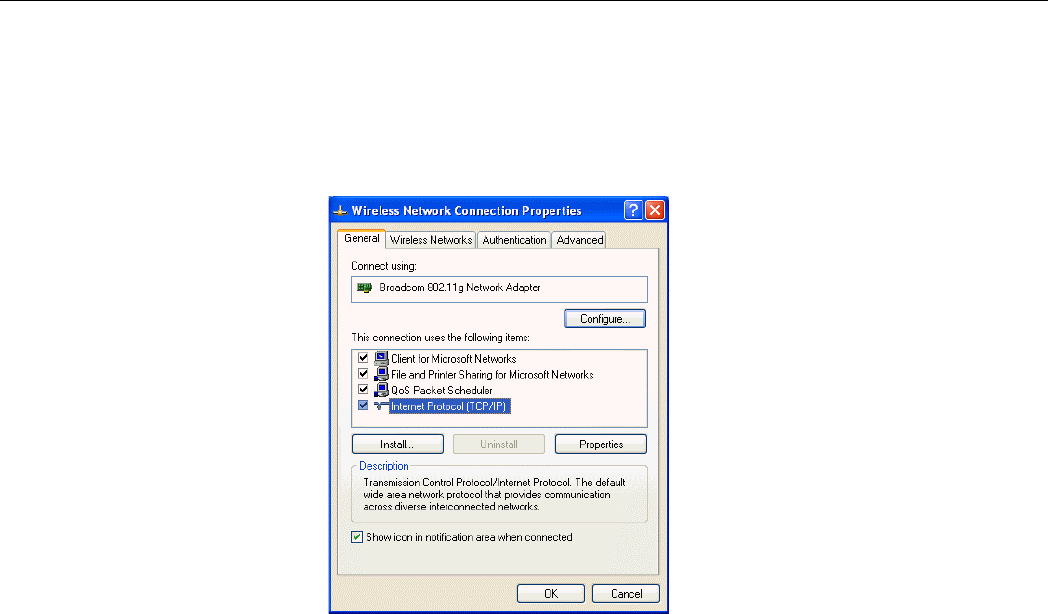
11Mbps Wireless LAN Card User's Manual
54
For Windows 2000/XP
1. Double-click Network Dial-up Connections (Windows 2000) or Network Connections
(Windows XP) on Control Panel, then Network Connections.
2. Right-click the Realtek RTL8180 Wireless … icon and click Properties.

Appendix B Setting Up TCP/IP
55
3. On the General tab, highlight Internet Protocol (TCP/IP) and then click Properties.
Option A: Use fixed IP address.
Enable the Use the following IP Address option. Enter the IP address, Subnet Mask
and Default gateway. Then click OK.
Option B: Use dynamic IP address
Select Obtain an IP address automatically.
4. Close the Local Area Connection Properties window. For Windows 2000, if prompted,
click Yes to restart your computer.
57
Glossary
10BaseT An IEEE standard (802.3) for operating 10 Mbps Ethernet networks (LANs) with twisted pair
cabling and a wiring hub.
Access Point An internetworking device that seamlessly connects wired and wireless networks. Access
Points combined with a distributed system support the creation of multiple radio cells that
enable roaming throughout a facility.
Ad-Hoc A network composed solely of stations within mutual communication range of each other (no
Access Point connected).
BSS Basic Service Set. A set of stations controlled by a single coordination function.
Channel A medium used to pass protocol data units that can be used simultaneously in the same volume
of space by other channels of the same physical layer, with an acceptably low frame error ratio
due to mutual interference.
ESS Extended Service Set. A set of one or more interconnected Basic Service Sets (BSSs) and
integrated Local Area Networks (LANs) can be configured as an Extended Service Set.

11Mbps Wireless LAN Card User's Manual
58
Ethernet The most widely used medium access method, which is defined by the IEEE 802.3 standard.
Ethernet is normally a shared media LAN; i.e., all the devices on the network segment share
total bandwidth. Ethernet networks operate at 10Mbps using CSMA/CD to run over 10BaseT
cables.
Gateway A network component that acts as an entrance to another network.
IEEE 802.11 The IEEE 802.xx is a set of specifications for LANs from the Institute of Electrical and
Electronic Engineers (IEEE). Most wired networks conform to 802.3, the specification for
CSMA/CD-based Ethernet networks or 802.5, the specification for token ring networks. 802.11
defines the standard for wireless LANs encompassing three incompatible (non-interoperable)
technologies: Frequency Hopping Spread Spectrum (FHSS), Direct Sequence Spread Spectrum
(DSSS), and Infrared. IEEE standards ensure interoperability between systems of the same
type.
Infrastructure A wireless network centered about an Access Point. In this environment, the Access Point not
only provides communication with the wired network but also mediates wireless network
traffic in the immediate neighborhood.
IP Internet Protocol. The standard protocol within TCP/IP that defines the basic unit of
information passed across an Internet connection by breaking down data messages into packets,
routing and transporting the packets over network connections, then reassembling the packets
at their destination. IP corresponds to the network layer in the ISO/OSI model.
IP Address An IP address is a 32-bit number that identifies each sender or receiver of information sent
across the Internet. An IP address has two parts: the identifier of a particular network on the
Internet and an identifier of the particular device (which can be a server or a workstation)
within that network.

Glossary
59
LAN Local Area Network. A communications network that serves users within a defined
geographical area. The benefits include the sharing of Internet access, files, and equipment,
such as printers and storage devices. Special network cabling (10BaseT) is often used to
connect the PCs together.
Radio
Frequency RF, Terms: GHz, MHz, Hz —The international unit for measuring frequency is Hertz (Hz),
equivalent to the older unit of cycles per second. One megahertz (MHz) is one Million-Hertz.
One giga hertz (GHz) is one Billion-Hertz. The standard U.S. electrical power frequency is 60
Hz, the AM broadcast radio frequency band is 0.55–1.6 MHz, the FM broadcast radio
frequency band is 88–108 MHz, and wireless 802.11 LANs operate at 2.4GHz.
SSID Service Set ID. A group name shared by every member of a wireless network. Only client PCs
with the same SSID are allowed to establish a connection.
Subnet Mask A value that defines whether your computer communicates only within your LAN or
communicates outside of your LAN, where it is routed out to the rest of the Internet. A Subnet
Mask that has the same first three components (for example, 255.255.255.0) is the routing
pattern for a Class C address.
TCP Transmission Control Protocol. The standard transport level protocol that provides the full
duplex, stream service on which many applications’ protocols depend. TCP allows a process on
one machine to send a stream of data to a process on another. Software implementing TCP
usually resides in the operating system and uses the IP to transmit information across the
network.

11Mbps Wireless LAN Card User's Manual
60
WEP Wired Equivalent Privacy. The optional cryptographic confidentiality algorithm specified by
802.11. The algorithm is being used to provide data confidentiality that is subjectively
equivalent to the confidentiality of a wired LAN medium that does not employ cryptographic
techniques to enhance privacy..
Federal Communication Commission Interference Statement
This equipment has been tested and found to comply with the limits for
a Class B digital device, pursuant to Part 15 of the FCC Rules. These
limits are designed to provide reasonable protection against harmful
interference in a residential installation. This equipment generates,
uses and can radiate radio frequency energy and, if not installed and
used in accordance with the instructions, may cause harmful
interference to radio communications. However, there is no guarantee
that interference will not occur in a particular installation. If this
equipment does cause harmful interference to radio or television
reception, which can be determined by turning the equipment off and
on, the user is encouraged to try to correct the interference by one of
the following measures:
- Reorient or relocate the receiving antenna.
- Increase the separation between the equipment and receiver.
- Connect the equipment into an outlet on a circuit different from that
to which the receiver is connected.
- Consult the dealer or an experienced radio/TV technician for help.
This device complies with Part 15 of the FCC Rules. Operation is
subject to the following two conditions: (1) This device may not cause
harmful interference, and (2) this device must accept any interference
received, including interference that may cause undesired operation.
FCC Caution: Any changes or modifications not expressly approved by
the party responsible for compliance could void the user's authority to
operate this equipment.
IMPORTANT NOTE:
FCC Radiation Exposure Statement:
This equipment complies with FCC radiation exposure limits set forth for an
uncontrolled environment. This equipment should be installed and operated
with minimum distance 20cm between the radiator & your body.
This transmitter must not be co-located or operating in conjunction with any
other antenna or transmitter.

This device is intended only for OEM integrators under the following
conditions:
1) The antenna must be installed such that 20 cm is maintained between the
antenna and users, and
2) The transmitter module may not be co-located with any other transmitter
or antenna.
As long as 2 conditions above are met, further transmitter test will not be
required. However, the OEM integrator is still responsible for testing their
end-product for any additional compliance requirements required with this
module installed (for example, digital device emissions, PC peripheral
requirements, etc.).
IMPORTANT NOTE: In the event that these conditions can not be met (for
example certain laptop configurations or co-location with another transmitter),
then the FCC authorization is no longer considered valid and the FCC ID can
not be used on the final product. In these circumstances, the OEM integrator
will be responsible for re-evaluating the end product (including the transmitter)
and obtaining a separate FCC authorization.
End Product Labeling
This transmitter module is authorized only for use in device where the
antenna may be installed such that 20 cm may be maintained between the
antenna and users (for example :Wireless Access Point). The final end
product must be labeled in a visible area with the following: “Contains TX FCC
ID: H8NWLL0010”.
Manual Information That Must be Included
The OEM integrator has to be aware not to provide information to the end
user regarding how to install or remove this RF module in the users manual of
the end product which integrate this module.
The users manual for OEM integrators must include the following information
in a prominent location “ IMPORTANT NOTE: To comply with FCC RF
exposure compliance requirements, the antenna used for this transmitter
must be installed to provide a separation distance of at least 20 cm from all
persons and must not be co-located or operating in conjunction with any other
antenna or transmitter.